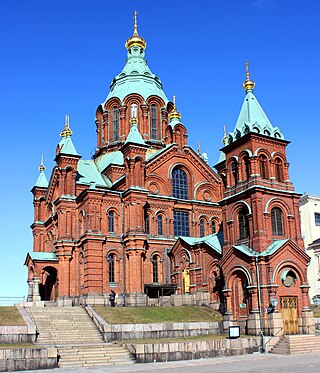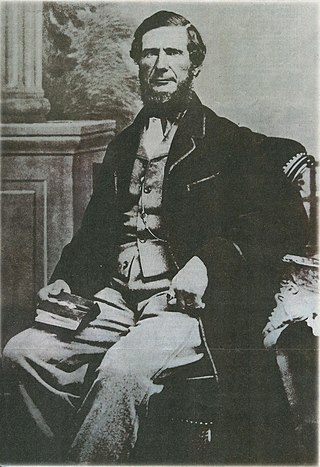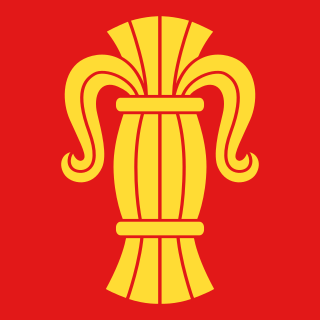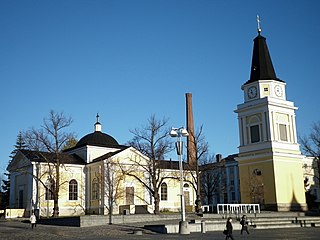
The Orthodox Church of Finland or Finnish Orthodox Church is an autonomous Eastern Orthodox archdiocese of the Ecumenical Patriarchate of Constantinople. The church has a legal position as a national church in the country, along with the Evangelical Lutheran Church of Finland.
The Province of Vaasa was a province of Finland, established in 1775 when Finland was an integrated part of Sweden from the southern part of Ostrobothnia County and disbanded in 1996. The province was named after the city of Vaasa.

Ostrobothnia is a region in western Finland. It borders the regions of Central Ostrobothnia, South Ostrobothnia, and Satakunta. It is one of four regions considered modern-day Ostrobothnia, hence it is also referred to as Coastal Ostrobothnia to avoid confusion.

Helsinki Cathedral is the Finnish Evangelical Lutheran cathedral of the Diocese of Helsinki, located in the neighborhood of Kruununhaka in the centre of Helsinki, Finland, at the Senate Square. The church was originally built from 1830 to 1852 as a tribute to the Grand Duke of Finland, Tsar Nicholas I of Russia. It was also known as St Nicholas's Church until the independence of Finland in 1917. It is a major landmark of the city, and possibly the most famous structure in Finland as a whole when viewed globally.

The University of Vaasa is a multidisciplinary, business-oriented university in Vaasa, Finland. The campus of the university is situated by the Gulf of Bothnia adjacent to downtown Vaasa. The university has evolved from a school of economics founded in 1968 to a university consisting of four different schools: The School of Accounting and Finance, The School of Management, The School of Marketing and Communications and the School of Technology and Innovations. University of Vaasa is one of the largest business universities in Finland. The university has personnel of around 500 which includes a teaching staff of 180 and 54 professors. Around 5000 students are currently studying in various degree programs at the university.

Carl Axel Setterberg (1812-1871) was a Swedish-born Finnish architect. Setterberg provided much of the urban design for the city of Vaasa, Finland.

Vaasan Sähkö Areena is a multipurpose arena in Vaasa, Finland. It was previously called the Kuparisaaren jäähalli and locals often use the old name in conversation. The arena first opened in 1971 and has undergone renovation and expansion several times. It is located approximately three kilometres south-east of downtown Vaasa.

Joensuu Church is located in the centre of Joensuu, North Karelia, Finland. The church was built in 1903 and designed by a Finnish church architect Josef Stenbäck. Architecturally it represents the Gothic Revival style, but it also has some features of National Romantic style. The high tower located in the northeast corner is the bell tower and in the lower southwest tower is the organ, which was built in 1969 by Organ Factory of Kangasala and has 36 stops. The church has 1000 seats. The altar painting is called The Crucifixion of Jesus and it is painted by Ilmari Launis in 1910.

Korsholm Church is a church building in the city of Vaasa, in the region of Österbotten in Finland.
Marcussen & Søn, also known as Marcussen and previously as Marcussen & Reuter, is a Danish firm of pipe organ builders. They were one of the first firms to go back to classical organ-building techniques, and have been producing mechanical-action organs since 1930. Aside from their many instruments in Denmark, they have built organs in northern Germany, Sweden, Finland, the Netherlands, Great Britain, South Africa, Japan, and the United States.
The governorates of the Grand Principality of Finland were the administrative division of the Grand Principality of Finland as part of the Russian Empire from 1809 to 1917.

The Holy Trinity Church is a Finnish Orthodox Church located in the Kruununhaka district of Helsinki, on the corner of Unioninkatu and Rauhankatu. The church was built in the neo-classical style in 1826 under the direction of the architect Carl Ludvig Engel, and was dedicated and opened in the following year. The Holy Trinity services the city's orthodox community with Divine Liturgy held in both Church Slavic and Finnish.

Vaasa, in the years 1855–1917 as Nikolainkaupunki, is a city on the west coast of Finland. It received its charter in 1606, during the reign of Charles IX of Sweden and is named after the Royal House of Vasa. Vaasa has a population of 68,880, and is the regional capital of Ostrobothnia. Vaasa is also well known as a major university and college city in Finland.

The Church of St. Lawrence is a church in Vantaa, Finland. Dating back to ca. 1450, it is the oldest building in Vantaa and all of Greater Helsinki. It is also the main church of the Tikkurila Parish. Along with its surrounding neighborhood, the church is a part of the Helsingin pitäjän kirkonkylä district, which is one of the best preserved historical parishes in all of Finland.

Espoonlahti Church is a Lutheran church situated in Espoonlahti, Espoo, Finland. It was designed by architects Timo and Tuomo Suomalainen, architects of the Rock Church, who were also members of the Espoonlahti congregation. The groundstone for the church was set in August 1979 and the building was completed in 1980. The organs were built and assembled in 1983. As the number of members in the congregation grew rapidly, additional rooms were soon needed. This new phase of building was completed in 1987, also by the architects Suomalainen.

The Port of Vaasa is a mixed-use port in the city of Vaasa on the west coast of Finland, in the Kvarken area of the Gulf of Bothnia. It is situated on the island of Vaskiluoto, some 2.5 kilometres (1.6 mi) due west of the Vaasa city centre, and connected to the mainland by the Vaskiluoto road and rail bridge. The port is serviced by the tracks and infrastructure of Vaskiluoto railway station.

The Vaskiluoto railway station is located in the city of Vaasa, Finland, on the island and district of Vaskiluoto. It is the terminus of the Seinäjoki–Vaasa railway, and it only serves cargo transport in the port of Vaasa; the nearest station with passenger services is Vaasa.

The Tampere Old Church is a wooden cross church opened in 1825 in Tampere, Finland near the Central Square. The old church is mainly used by the Swedish-speaking Lutheran congregation in Tampere. The church was designed by Italian-born Carlo Bassi and completed in 1824. The belfry, designed by C. L. Engel, was completed in 1828. The Old Church is the oldest surviving building in the city center of Tampere, and the adjoining belfry is the second oldest.

The Alexander Church is a stone church in Tampere, Finland, and it is part of the Tampere Cathedral Parish. It is located in the Kaakinmaa district in the city center of Tampere, on the edge of the Hämeenpuisto park along the Pirkankatu street. The church, designed by architect Theodor Decker, was built of brick between 1880 and 1881. It is named after Emperor Alexander II of Russia. The church is surrounded by Pyynikki Church Park, a former cemetery.

The Statue of Liberty is a monumental bronze sculpture complex located in the Market Square of Vaasa in Ostrobothnia, Finland. The statue celebrates the victory of the Whites in the Finnish Civil War in 1918. The height of the work with its pedestals is 14 metres (46 ft) and the height of the part on top of the pedestal is 6 metres (20 ft). The sculpture weighs 3.6 tonnes. The sculpture was designed by Yrjö Liipola and Jussi Mäntynen, and it was unveiled in 1938.

















